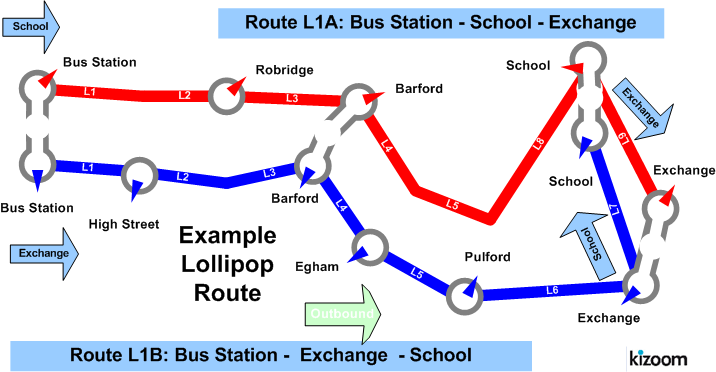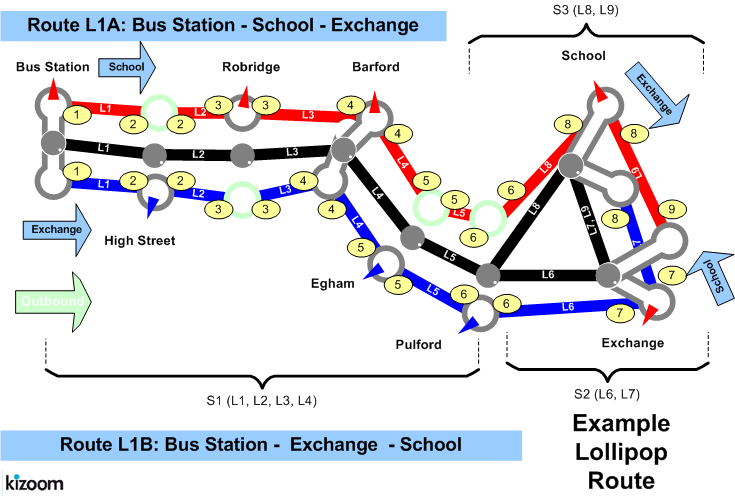TransXChange
Examples 2.5 - Lollipop route
Summary
Same stops covered by two different routes in different directions in a partial lollipop. See also Hail and Ride for a full lollipop topology.
- Lollipop route, with two journeys proceeding round the loop in opposite directions (In this example neither route completes the full lollipop course)
- Two services run by two different operators, sharing a line label.
- Two different physical routes with the same line label.
- Timing status on stop usage other than 'Principle Timing Point (PTP).
- Additional operating days for regular and bank holiday operation.
- Alternative Bank Holidays only operation
- Express stopping pattern for some journeys.
- Use of Stop Sequence Numbers to control row order in matrix..
- Use of Dynamic Destination headings.
- Reuse of shared sections.
- Reuse of VehicleJourney Link.
- Layover Point.
- General Schema.
- Minimum Layover Duration (TXC v2.4)
- Partial Frequent Services (TXC v2.4).
Published as PDF:
- PDF general: With publish options lollipop.xml -full TransXChange publisher option (includes all stops).
- PDF vosa: With publish options lollipop.xml -vosa TransXChange publisher option (includes only stop usages with a timing status of 'PTP' ).
Route Map

Timetable
Bus Station To Exchange
| Column | |||||||
| Operator | |||||||
| Line | |||||||
| Bus Station | 15:55 | 16:15 | 16:35 | 16:40 | 16:55 | 16:35 | |
| High St | 16:46 | ||||||
| Robridge | 16:26 | ||||||
| Barford | 16:09 | 16:29 | 16:49 | 16:54 | 17:09 | 16:49 | |
| Egham | 16:12 | 16:52 | 16:57 | 17:12 | 16:52 | ||
| Pulford | 16:15 | 16:55 | 17:00 | 17:15 | 16:55 | ||
| Exchange | 16:32 | 16:52 | 17:12 | 17:32 | 17:22 | ||
| School | 16:53 | 17:16 | |||||
| Exchange | 17:17 |
The XML Representation
Service Registration
- The service is not registered
- There are two
Operatorinstances, 'ACO'. and 'RED'
Service Structure
The detailed map below shows the sections and stop sequences used.
- There are two
Serviceinstances whoseLinesare labelled to appear to the public as the same:- S1, which has two
Lineinstances; L1, labelled 'L1A', and L2, labelled 'L1B' S1 is run byOperator'ACO'. - S2 which has Li
ne L3 also labelled 'L1B'. S2 is run byOperator'RED'.
- S1, which has two
- There are three
RouteSectioninstances;- RS1: 'Bus Station' to 'Pulford', containing
RouteLinkinstances RL1 to RL5. - RS2: 'Pulford' to 'School ' via 'Exchange', containing
RouteLinkinstances RL6 and RL7. - RS3: 'Pulford' to 'Exchange' via 'School', containing
RouteLinkinstances RL8 and RL9.
- RS1: 'Bus Station' to 'Pulford', containing
- There are two
Routeinstances:- R1: 'Bus Station to School (via Exchange)', containing RS1 and RS2.
- R2: 'Bus Station to Exchange (via School)', containing RS1 and RS3.
- There are three corresponding
JourneyPatternSectioninstances, JS1, JS2 and JS3, one for each route section.- Egham is not a 'Principle Timing Point' ('PTP'), so for the call at Egham the JourneyP
atternTiminkLink has an overrideTimingStatusof 'Timing Information Point' (''TIP').
- Egham is not a 'Principle Timing Point' ('PTP'), so for the call at Egham the JourneyP
- S1 has two
JourneyPatterninstances:- JP1: Following
RouteR1, with sections JS1 and JS2, passing 'Pulford' without stopping. - JP2: Following
RouteR2, with sections JS1 and JS3.
- JP1: Following
- S2 has one
JourneyPatterninstance:- JP3: Also following
RouteR2, with sections JS1 and JS3, passing 'Pulford' without stopping. It contains two named layover points lay_1 and lay_2.
- JP3: Also following
- There are six
VehicleJourneyinstances one for each column.- There are five
VehicleJourneyinstances Vj1-Vj5 that run on on regular days - see columns #1- #5, - There is one
VehicleJourneyinstance Vj6 that run on Bank Holiday only service see column #6.
- There are five
- S1 has five
VehicleJourneyinstances:- VJ1: following
JourneyPatternJP1 overRouteR1, 'Bus Station to School (via Exchange)' , asLine'L1B', passing 'High Street' and 'Robridge', without stopping. Short working of the second section, i.e. termination at Exchange, is indicated by a dead run. - VJ2: also following Journe
yPattern JP1 overRouteR1, 'Bus Station to School (via Exchange)' but asLine'L1A', passing 'High Street', 'Egham' and 'Pulford' without stopping. - VJ3: reuses the timing links of VJ1, and so also follows
JourneyPatternJP1 overRouteR1, 'Bus Station to School (via Exchange)' . - VJ5: reuses the timing links of VJ1, and so also follows
JourneyPatternJP1 overRouteR1, 'Bus Station to School (via Exchange)' . - VJ5: reuses the timing links of VJ1, and so also follows
JourneyPatternJP1 overRouteR1, 'Bus Station to School (via Exchange)' . Runs only on bank holidays
- VJ1: following
- S2 has one
VehicleJourneyinstance:- VJ4: following JourneyPat
tern JP3 overRouteR2, 'Bus Station to Exchange (via School)', asLineL3 , which has the same label of 'L1B' as S1/L2 , although it actually goes round the last two stops in a different sequence from the other journeys with the same label, and so needs a different underlying Route. VJ4 passes 'Robridge', without stopping.
- VJ4: following JourneyPat
Operating Days
- The Service Operating
Period for SV_1 starts on01/01/2004 for all vehicle journeys, and continues until 13/06/2005 - The OperatingProfile for the
ServiceSV_1 states values that apply to all journeys unless overridden on a journey pattern or individual vehicle journey.- The
RegularDayTypeDaysOfWeek specifies journeys of the service by default runsMondaytoSaturdaythroughout the year - The
BankHolidayOperation/DaysOfOperationstates journeys of the service run onJan2ndScotland,MayDay,EasterMonday,SpringBank,StAndrewsDay, AugustBankHolidayScotland,ChristmasDayHoliday,BoxingDayHolidayandChristmasEve. - The
BankHolidayOperation/DaysOfNonOperationstates journeys of the service do not run onChristmasDay,BoxingDay,GoodFriday, NewYearsDay,NewYearsDayHolidayandNewYearsEve.
- The
- The
Vehicle JourneysVJ1 and VJ5 have a different set of day type specified .- The RegularDayType
DaysOfWeekspecifies journeys of the service runMonday,Wednesday,Friday,Sundaythroughout the year.
- The RegularDayType
- The
Serviceoperating period for SV_2 starts on 01/01/2004 for all vehicle journeys, and continues until 13/06/2005. - The
OperatingProfilefor theServiceSV_2 states values that apply to all journeys unless overridden on a journey pattern or individual vehicle journey.- The
RegularDayTypeDaysOfWeekspecifies journeys of the service by default runsMondaytoSundaythroughout the year. - The BankHolidayO
peration /DaysOfNonOperationstates journeys of the service do not run on Christmas, i.e.ChristmasDay, andBoxingday.
- The
Use of Sections & Stop Sequence Numbers
Sections are used to reuse links between journeys.
Stop sequence numbers are used to coerce a specific ordering of the stops within a matrix timetable when published. The following diagram shows the journey pattern sections annotated with stop section numbers.
Page last updated: 2010/04/25

